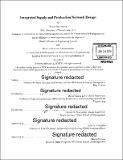| dc.contributor.advisor | David Simchi-Levi and Donald B. Rosenfield. | en_US |
| dc.contributor.author | Bakousseva, Renata | en_US |
| dc.contributor.other | Leaders for Global Operations Program. | en_US |
| dc.date.accessioned | 2016-12-05T19:55:45Z | |
| dc.date.available | 2016-12-05T19:55:45Z | |
| dc.date.copyright | 2016 | en_US |
| dc.date.issued | 2016 | en_US |
| dc.identifier.uri | http://hdl.handle.net/1721.1/105632 | |
| dc.description | Thesis: S.M. in Engineering Systems, Massachusetts Institute of Technology, School of Engineering, Institute for Data, Systems, and Society, 2016. In conjunction with the Leaders for Global Operations Program at MIT. | en_US |
| dc.description | Thesis: M.B.A., Massachusetts Institute of Technology, Sloan School of Management, 2016. In conjunction with the Leaders for Global Operations Program at MIT. | en_US |
| dc.description | Cataloged from PDF version of thesis. | en_US |
| dc.description | Includes bibliographical references (page 59). | en_US |
| dc.description.abstract | As Company X looks to improve customer service and deliver new growth opportunities, it is driving toward a more efficient, aligned and effective organization that eliminates waste through integration of its supply and production networks. The current manufacturing system is optimized for high volume products with low demand variation signals, and is used for all products regardless of demand characteristics. The effects of such a system on the supply network are higher holding cost and stale inventory, while the effects on the business are lost sales and higher total delivered cost. A more responsive production system is an opportunity to reduce strain on the supply network, reduce total delivered cost and improve product fulfillment. Analysis of a portfolio of products demonstrates two main findings: (1) considerable impact of inventory cost on the total delivered cost and (2) a definitive case for differentiated manufacturing strategy - for high and low volume products. Previously only manufacturing cost had been used to make the decision of which system might better fit the goals of providing products in a timely and cost efficient manner. However, the uncovering of the impact of inventory cost on the total delivered cost has challenged that perception. An analysis was also performed on various algorithms which optimize (1) the product lot size and (2) job scheduling on machines. EOQ and a Mixed Integer Program were both analyzed for lot size determination, with the latter demonstrating more cost efficient and production efficient results due to more flexibility with the time scale and the consideration of manufacturing capacity. Finally, a couple of bin packing algorithm heuristics were tested for job scheduling. The results demonstrated significant time savings in job scheduling and have highlighted the need to automate the scheduling process. | en_US |
| dc.description.statementofresponsibility | by Renata Bakousseva. | en_US |
| dc.format.extent | 59 pages | en_US |
| dc.language.iso | eng | en_US |
| dc.publisher | Massachusetts Institute of Technology | en_US |
| dc.rights | M.I.T. theses are protected by copyright. They may be viewed from this source for any purpose, but reproduction or distribution in any format is prohibited without written permission. See provided URL for inquiries about permission. | en_US |
| dc.rights.uri | http://dspace.mit.edu/handle/1721.1/7582 | en_US |
| dc.subject | Institute for Data, Systems, and Society. | en_US |
| dc.subject | Sloan School of Management. | en_US |
| dc.subject | Engineering Systems Division. | en_US |
| dc.subject | Leaders for Global Operations Program. | en_US |
| dc.title | Integrated supply and production network design | en_US |
| dc.type | Thesis | en_US |
| dc.description.degree | S.M. in Engineering Systems | en_US |
| dc.description.degree | M.B.A. | en_US |
| dc.contributor.department | Leaders for Global Operations Program at MIT | en_US |
| dc.contributor.department | Massachusetts Institute of Technology. Engineering Systems Division | |
| dc.contributor.department | Massachusetts Institute of Technology. Institute for Data, Systems, and Society | |
| dc.contributor.department | Sloan School of Management | |
| dc.identifier.oclc | 963212792 | en_US |
